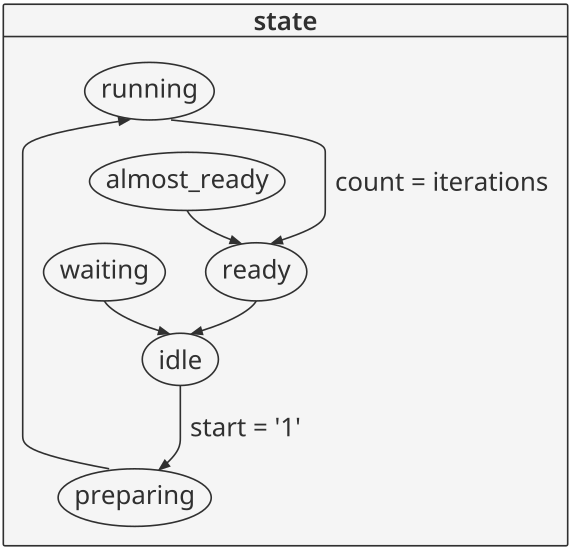
State diagram in Sigasi Visual HDL Professional
In VHDL, Finite State Machines (FSMs) can be written in various ways. This article addresses the encoding of, and the data types used, for the state register. The encoding of the states of an FSM affects its performance in terms of speed, resource usage (registers, logic) and potentially power consumption. As we will see, enumerated datatypes are preferred for clarity and easy of maintenance.
State encoding algorithms include:
- Binary encoding: states are enumerated with binary encoded numbers:
"000","001","010","011","100"… - One-hot encoding: states are represented as bit patterns with exactly 1
'1':"000001","000010","000100","001000","010000"… - Gray coding: the encoding of successive states only differ by one bit:
"000","001","011","010","110"…
The preferred encoding depends on the nature of the design. Binary encoding minimizes the length of the state vector, which is good for CPLD designs. One-hot encoding is usually faster and uses more registers and less logic. That makes one-hot encoding more suitable for FPGA designs where registers are usually abundant. Gray encoding will reduce glitches in an FSM with limited or no branches.
FSMs should be designed such that they’re easy to understand and maintain. At the same time, the designer must retain control of the FSM’s state encoding. Generally speaking, a state register can be implemented in two different ways: either as a vector type or as an enumeration type.
Consider the following examples:
-- Warning -- This is **NOT** recommended!
signal state: std_logic_vector(3 downto 0);
-- [some code omitted]
case state is
when "0001" => -- do something
state <= "0010";
when "0010" => -- do something
state <= "0100";
when "0100" => -- do something
state <= "1000";
when "1000" => -- do something
state <= "0001";
With a vector type, the designer has perfect control over the encoding of the state vector. However, it is hard to know what each state means and changes are cumbersome. If a state needs to be inserted, the encoding of all further states need to be updated wherever used.
With an enumeration type, the design becomes much easier to understand and maintain:
type t_state is (IDLE, START, RUN, DONE); -- enumerate all states
signal state: t_state;
-- [some code omitted]
case state is
when IDLE => -- do something
state <= START;
when START => -- do something
state <= RUN;
when RUN => -- do something
state <= DONE;
when DONE => -- do something
state <= IDLE;
States can be added or modified easily, and other states are not affected when one state is added or modified. The encoding of the states however is magically implemented by the RTL synthesis tool. Fortunately, most RTL synthesis tools have ways for the designer to control the state encoding of enumerated state types.
In many cases, one would like to define the state encoding style. The example below shows how that can be achieved at the type level:
type t_state is (IDLE, START, RUN, DONE); -- enumerate all states
attribute enum_encoding : string;
attribute enum_encoding of t_state : type is "one-hot"; -- encoding style of the enumerated type
signal state: t_state;
-- [some code omitted]
case state is
when IDLE => -- do something
state <= START;
when START => -- do something
state <= RUN;
when RUN => -- do something
state <= DONE;
when DONE => -- do something
state <= IDLE;
The enum_encoding defines the FSM’s state encoding style.
Support of enumeration encoding styles differs between RTL synthesis tools, so have a look at the manual of yours for supported styles.
Also, some RTL synthesis tools e.g. Xilinx XST and Synopsys Synplify require additional settings for the enum_encoding attribute to take effect.
Alternatively, the state encoding style can be defined at the signal level rather than at the type level.
The fsm_state is used for that purpose.
This way, multiple FSMs with the same set of states can each have a different state encoding.
The allowed values are: BINARY, GRAY, ONE_HOT, ONE_COLD or AUTO. With Synopsys Synplify, use attribute syn_encoding instead of fsm_state.
type t_state is (IDLE, START, RUN, DONE); -- enumerate all states
signal state: t_state;
attribute fsm_state : string;
attribute fsm_state of state : signal is "ONE_HOT"; -- encoding style of the state register
-- [some code omitted]
case state is
when IDLE => -- do something
state <= START;
when START => -- do something
state <= RUN;
when RUN => -- do something
state <= DONE;
when DONE => -- do something
state <= IDLE;
In the above examples, only the encoding style of the state vector is defined.
Using the enum_encoding attribute, the designer can also fully control the encoding of each individual state.
If a state is added, its encoding needs to be added in the attribute.
The example below shows how that can be achieved.
type t_state is (IDLE, START, RUN, DONE); -- enumerate all states
attribute enum_encoding : string;
attribute enum_encoding of t_state : type is "0001 0010 0100 1000"; -- encoding of each state
signal state: t_state;
-- [some code omitted]
case state is
when IDLE => -- do something
state <= START;
when START => -- do something
state <= RUN;
when RUN => -- do something
state <= DONE;
when DONE => -- do something
state <= IDLE;
In conclusion, enumerated types are preferred for FSM state vectors. Well chosen enumeration literals make the FSM more easy to read, understand and maintain. With an enumerated type, states can be added to or removed from the FSM without affecting the other states. The size of the state vector will be adjusted during RTL synthesis. Still, the designer retains as much control of the state encoding as they desire.
See also
- Records in VHDL: Initialization and Constraining unconstrained fields (blog post)
- Signal Assignments in VHDL: with/select, when/else and case (blog post)
- Using Sigasi Studio's Graphics Configuration (legacy)
- "Use" and "Library" in VHDL (blog post)
- VHDL Pragmas (blog post)